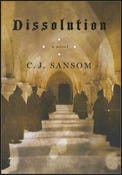Dissolution, the first of the Matthew Shardlake mysteries, is set in 1537, shortly after the death of Henry VIII's third wife, Jane Seymour. Inevitably, the mourning for Queen Jane recalls the more complicated affair of Anne Boleyn's death, in which the fictional Matthew Shardlake's boss, the historical Thomas Cromwell, was deeply involved. Meanwhile, the dissolution of England's monasteries, set in motion by events surrounding Henry's marriage to Anne, proceeds apace.
The monasteries were not dissolved all at once. The king's first efforts at suppressing monasteries set off an uprising of dangerous strength. He and Cromwell moved more carefully after that, forcibly dissolving monasteries only where a strong case could be made for moral laxity or disobedience to the Crown amounting to treason. Instead, abbots and monastic administrators were encouraged to agree to voluntary dissolution. In the novel, one of Cromwell's agents has been murdered while carrying out a monastery visitation. He had been looking for evidence of misbehavior that would allow him to "encourage" the monks more persuasively. Shardlake's mission is to find out who murdered the agent and obtain the abbot's agreement to a dissolution.
Shardlake has a misshapen back which pains him both physically and emotionally. As a child, he was educated in a monastery where he learned first-hand that monks are not necessarily compassionate, godly men. He is, therefore, a whole-hearted believer in the reforms Cromwell is carrying out. But his strong moral sensibilities and keen intelligence introduce doubts about Cromwell's work and his own role in it, doubts which threaten to give him as much pain as his bent back.
The thoughtful literary depth of this novel does not displace the mystery, a genuine puzzler whose solution is both credible and surprising. The mystery turns on the personalities and character of the various suspects, all at the center of the monastery's work and all, sympathetic or otherwise, portrayed as deeply human individuals. (2003; 390 pages, including a Historical Note)




